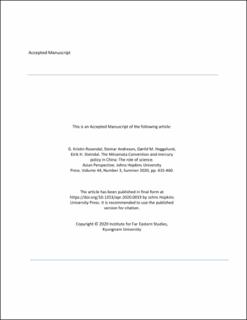| dc.contributor.author | Rosendal, G. Kristin | |
| dc.contributor.author | Andresen, Steinar | |
| dc.contributor.author | Heggelund, Gørild M | |
| dc.contributor.author | Steindal, Eirik H. | |
| dc.date.accessioned | 2021-06-01T06:19:54Z | |
| dc.date.available | 2021-06-01T06:19:54Z | |
| dc.date.created | 2020-08-27T10:35:03Z | |
| dc.date.issued | 2020 | |
| dc.identifier.citation | Asian Perspective. 2020, 44 (3), 435-460. | en_US |
| dc.identifier.issn | 0258-9184 | |
| dc.identifier.uri | https://hdl.handle.net/11250/2757121 | |
| dc.description | This is an accepted manuscript version. | en_US |
| dc.description.abstract | What role has science played in China’s decision to support and ratify the Minamata Convention, and in its domestic policies on mercury? Since 2000 there has been a strong increase in internationally produced knowledge on mercury and China has increasingly taken part in this process, also developing a stronger domestic knowledge base for handling the mercury problem. We analyse three aspects of science that are assumed to enhance trust: credibility, legitimacy and relevance. These are explored in the study of science-policy relations in China as we examine changes in domestic mercury policies and related institutions. Also discussing the effects of other explanatory factors, we find that domestically produced scientific information may be central for understanding China’s ratification of the Minamata Convention and subsequent domestic mercury policies. The study bridges the gap between capacity building in emerging economies and how domestically produced scientific information may strengthen national environmental policy making. | en_US |
| dc.language.iso | eng | en_US |
| dc.publisher | Johns Hopkins University Press | en_US |
| dc.title | The Minamata Convention and mercury policy in China: The role of science | en_US |
| dc.type | Peer reviewed | en_US |
| dc.type | Journal article | en_US |
| dc.description.version | acceptedVersion | en_US |
| dc.rights.holder | Copyright © 2020 Institute for Far Eastern Studies,
Kyungnam University | en_US |
| dc.source.pagenumber | 435-460 | en_US |
| dc.source.volume | 44 | en_US |
| dc.source.journal | Asian Perspective | en_US |
| dc.source.issue | 3 | en_US |
| dc.identifier.doi | 10.1353/apr.2020.0019 | |
| dc.identifier.cristin | 1825453 | |
| dc.relation.project | Norges forskningsråd: 268443 | en_US |
| dc.relation.project | Fridtjof Nansens institutt: 436 | en_US |
| cristin.ispublished | true | |
| cristin.fulltext | postprint | |
| cristin.qualitycode | 1 | |
